Family name: Iridaceae A.L. Jussieu
Synonym(s): Geosiridaceae Jonker, nom. cons.; Gladiolaceae Raf.; Hewardiaceae Nakai, nom. illeg.; Isophysidaceae F. A. Barkley; Ixiaceae Horan.
Common name(s): iris family
*Number of genera/species: 66/2,400
List of genera records in GRIN-Global
seed
Fruit a loculicidal capsulecapsule:
a dry, dehiscent fruit derived from a compound ovary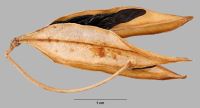 , rarely circumscissilecircumscissile:
, rarely circumscissilecircumscissile:
(~pyxis); type of capsular dehiscence, opens by a lid (splitting transversely)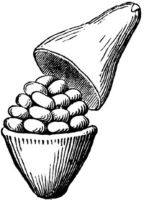 (Geosiris) or indehiscentindehiscent:
(Geosiris) or indehiscentindehiscent:
not opening on its own, as in a fruit
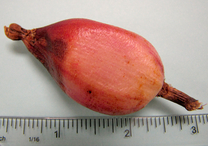 (some species of Dietes and Libertia), 2–100 mm long, globoseglobose:
(some species of Dietes and Libertia), 2–100 mm long, globoseglobose:
3D shape—more or less spherical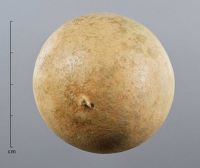 to triangulartriangular:
to triangulartriangular:
2D shape—three relatively straight sides with distinct corners; more angular than teardrop-shaped , tereteterete:
, tereteterete:
approximately circular in cross section; width and thickness approximately equal
 or angledangular:
or angledangular:
2D shape—having sides that meet at acute or obtuse angles
in transection, sometimes beakedbeak:
a usually firm, terminal appendage, sometimes tapered (some species of Iris, Dietes, Ferraria, Hermodactylis, some species of Moraea), sometimes spathe tube or perianthperianth:
(some species of Iris, Dietes, Ferraria, Hermodactylis, some species of Moraea), sometimes spathe tube or perianthperianth:
collective term for calyx and corolla of a flower
 persistent, with few to many seeds. Pericarppericarp:
persistent, with few to many seeds. Pericarppericarp:
fruit wall or fruit coat
black, brown, green, or white, dulldull:
reflecting only a low proportion of incident light, with no apparent sheen , membranousmembranous:
, membranousmembranous:
texture—extremely thin, pliable, and fairly tough
to woodywoody:
texture—consisting mainly of indurate lignified tissues, characteristic of or resembling wood
, sometimes pubescentpubescent:
surface relief—bearing hairs
, smooth, wrinkledwrinkled:
surface relief—shallow, irregular folds and furrows covering the surface; appearing overall though crumpled and then spread out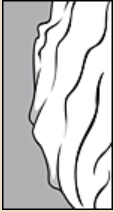 , papillatepapillate:
, papillatepapillate:
surface relief—bearing minute, distinct, broad-based projections, tapering to a rounded apex , groovedgrooved:
, groovedgrooved:
surface relief—linear depressions that may be single or form a series of grooves over the surface or ribbedribbed:
or ribbedribbed:
surface relief—wide, prominent, linear ridges that are generally rounded and longitudinally situated on the surface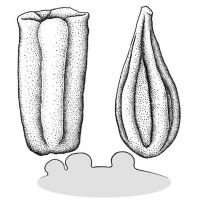 . CapsulesCapsule:
. CapsulesCapsule:
a dry, dehiscent fruit derived from a compound ovary radially winged in Aristea section Racemosae.
radially winged in Aristea section Racemosae.
Seeds usually angularangular:
2D shape—having sides that meet at acute or obtuse angles
, sometimes globoseglobose:
3D shape—more or less spherical , discoiddiscoid:
, discoiddiscoid:
3D shape—resembling a disc
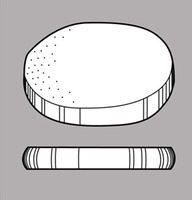 (Diplarrhena, some species of Moraea), compressedcompressed:
(Diplarrhena, some species of Moraea), compressedcompressed:
flattened; in grasses, used to denote compression (not necessarily flattened) either laterally or dorsiventrally
to flattened, tereteterete:
approximately circular in cross section; width and thickness approximately equal
 , or triangulartriangular:
, or triangulartriangular:
2D shape—three relatively straight sides with distinct corners; more angular than teardrop-shaped in transection, minute in Geosiris, 1–18 mm long in the other genera. Hilumhilum:
in transection, minute in Geosiris, 1–18 mm long in the other genera. Hilumhilum:
on seeds, the scar indicating where the funiculus was attached; on grass caryopses, the scar visible on the outer fruit surface revealing where the seed is attached on the inner fruit wall surface; or in Asteraceae cypselae, the scar visible on the outer fruit wall revealing where the fruit was attached to the receptacle punctate or if larger, circularcircular:
punctate or if larger, circularcircular:
(of embryo) linear embryo is curved into an "O" shape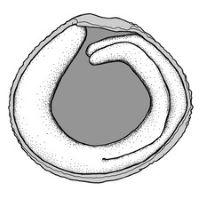 . Seeds winged at both ends in Pardanthopsis, one or two winged in Watsonia, and two winged in Tritoniopsis. Rapheraphe:
. Seeds winged at both ends in Pardanthopsis, one or two winged in Watsonia, and two winged in Tritoniopsis. Rapheraphe:
a ridge or seam on the seed coat, formed by the portion of the funiculus united to the ovule wall in longitudinally curved ovules inflated in Freesia. Elaisomes present in Patersonia and some species of Iris (formally placed in Hermodactylus); arilsaril:
inflated in Freesia. Elaisomes present in Patersonia and some species of Iris (formally placed in Hermodactylus); arilsaril:
(broad sense) appendicular structure that wholly or partly envelops a seed and is produced from or a modification of the funicle, raphe, or outer integument; usually fleshy or pulpy, sometimes spongy or tufted-capillate, often brightly colored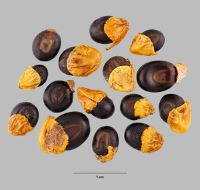 present in some species of Iris. Seed coat brown or black, dulldull:
present in some species of Iris. Seed coat brown or black, dulldull:
reflecting only a low proportion of incident light, with no apparent sheen or shinyshiny:
or shinyshiny:
uniformly reflecting a high proportion of incident light at all angles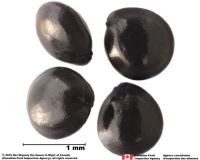 , leatheryleathery:
, leatheryleathery:
texture—moderately thick, tough, and very pliable
, fleshy (rarely), membranousmembranous:
texture—extremely thin, pliable, and fairly tough
, or corkycorky:
firm, relatively light, discontinuous but strongly cohesive, and resilient
, sometimes pubescentpubescent:
surface relief—bearing hairs
, smooth or variously sculptured.
Embryo well developed, linearlinear:
(shape) long, narrow, and uniform in width; (of embryo) embryo is straight and much longer than wide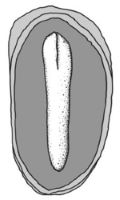 , curvedcurved:
, curvedcurved:
(of embryo) linear embryo is curved into an arch or horseshoe with the ends far apart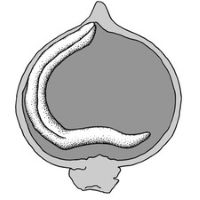 or straight, partially filling seed coat, sometimes chlorophyllous.
or straight, partially filling seed coat, sometimes chlorophyllous.
Endosperm copious hard, fleshy or cartilaginouscartilaginous:
texture—firm, dense, tough, somewhat pliable, and resilient, like cartilage
.
Noxious Weeds: USA Federal Noxious Weed List, terrestrial, Moraea collina Thunb., Moraea flaccida (Sweet) Steud., Moraea miniata Andrews, Moraea ochroleuca (Salisb.) Drapiez, Moraea pallida (Baker) Goldblatt.
Federal Noxious Weed Disseminules of the US tool provides descriptions and images of these species.
Commonly intercepted at ports. Weedy in grasslands, wetlands, vineyards, and plowed fields, spreading by seed reproduction.
| Fruit | ||
| Type | loculicidalloculicidal: type of capsular dehiscence, opening longitudinally through the locules (compare septicidal) 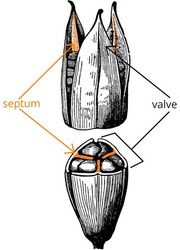 capsulecapsule: capsulecapsule:a dry, dehiscent fruit derived from a compound ovary  (sometimes indehiscentindehiscent: (sometimes indehiscentindehiscent:not opening on its own, as in a fruit  ), rarely circumscissilecircumscissile: ), rarely circumscissilecircumscissile:(~pyxis); type of capsular dehiscence, opens by a lid (splitting transversely)  |
|
| Size range | 2–100 mm long | |
| Shape(s) | triangulartriangular: 2D shape—three relatively straight sides with distinct corners; more angular than teardrop-shaped  , conicalconical: , conicalconical:3D shape—cone-shaped, with the point of attachment at the broad end 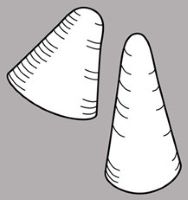 , oblongoblong: , oblongoblong:2D shape—much longer than broad with nearly parallel sides, corners are rounded 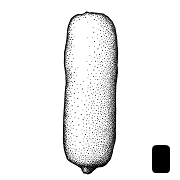 , globoseglobose: , globoseglobose:3D shape—more or less spherical  , ovoidovoid: , ovoidovoid:3D shape—ovate 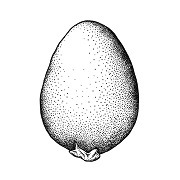 , fusiformfusiform: , fusiformfusiform:spindle-shaped; broadest at the middle and tapering at both ends  , ellipsoidellipsoid: , ellipsoidellipsoid:3D shape—elliptic , cylindricalcylindrical: 3D shape—a cylinder, with parallel sides and a circular cross-section; tubular or rod-shaped |
|
| Texture | leatheryleathery: texture—moderately thick, tough, and very pliable , membranousmembranous: texture—extremely thin, pliable, and fairly tough , firm, cartilaginouscartilaginous: texture—firm, dense, tough, somewhat pliable, and resilient, like cartilage , woodywoody: texture—consisting mainly of indurate lignified tissues, characteristic of or resembling wood |
|
| Surface relief | smooth or roughenedroughened: texture—having a small, stout, stiff, more or less acute protrusions , wrinkledwrinkled: surface relief—shallow, irregular folds and furrows covering the surface; appearing overall though crumpled and then spread out  , papillatepapillate: , papillatepapillate:surface relief—bearing minute, distinct, broad-based projections, tapering to a rounded apex  , groovedgrooved: , groovedgrooved:surface relief—linear depressions that may be single or form a series of grooves over the surface  , ribbedribbed: , ribbedribbed:surface relief—wide, prominent, linear ridges that are generally rounded and longitudinally situated on the surface  , sometimes pubescentpubescent: , sometimes pubescentpubescent:surface relief—bearing hairs |
|
| Color(s) | brown, black, white, green | |
| Seed | ||
| Size range | 0.8–18 mm long | |
| Shape(s) | globoseglobose: 3D shape—more or less spherical  , triangulartriangular: , triangulartriangular:2D shape—three relatively straight sides with distinct corners; more angular than teardrop-shaped  , irregular, polygonalpolygonal: , irregular, polygonalpolygonal:angular , ellipsoidellipsoid: 3D shape—elliptic , lens-shapedlens-shaped: 2D shape—round and flattened with two curved (convex) surfaces , conicalconical: 3D shape—cone-shaped, with the point of attachment at the broad end  , teardrop-shapedteardrop-shaped: , teardrop-shapedteardrop-shaped:2D shape—widest point is toward one end of the fruit, the other end tapers sharply to a pointed end  , D-shapedD-shaped: , D-shapedD-shaped:2D shape—has one straight margin and one curved margin, resembling the shape of the letter D |
|
| Surface relief | smooth, colliculatecolliculate: surface relief—covered with small, round projections, similar to blistered 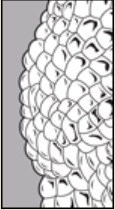 , reticulatereticulate: , reticulatereticulate:surface relief—netted, raised walls or concave grooves forming a net-like surface pattern with flat, concave, or convex interspaces  , ridgedridged: , ridgedridged:surface relief—raised, thick ridges, sharp edged or rounded, usually in a series that may cover the entire surface  , roughenedroughened: , roughenedroughened:texture—having a small, stout, stiff, more or less acute protrusions , wrinkledwrinkled: surface relief—shallow, irregular folds and furrows covering the surface; appearing overall though crumpled and then spread out  , striatestriate: , striatestriate:surface relief—having fine, parallel lines, grooves or ridges 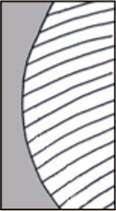 , granulargranular: , granulargranular:surface relief—having a grainy surface 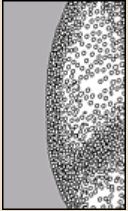 |
|
| Color(s) | black, brown, red | |
| Other | ||
| Embryo | well developed, linearlinear: (shape) long, narrow, and uniform in width; (of embryo) embryo is straight and much longer than wide  , curvedcurved: , curvedcurved:(of embryo) linear embryo is curved into an arch or horseshoe with the ends far apart  or straight, partially filling seed coat or straight, partially filling seed coat |
|
| Nutritive tissue | endosperm copious hard, fleshy or cartilaginouscartilaginous: texture—firm, dense, tough, somewhat pliable, and resilient, like cartilage |
|
Worldwide.
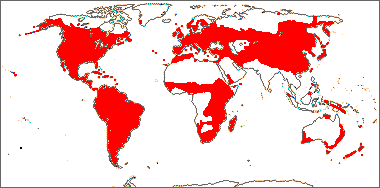
Distribution map courtesy of Angiosperm Phylogeny Website.
Baskin and Baskin 2021Baskin and Baskin 2021:
Baskin C and Baskin J. 2021. Relationship of the lateral embryo (in grasses) to other monocot embryos: A status up-grade. Seed Science Research 31 (3): 199-210. doi:10.1017/S0960258521000209; Dahlgren et al. 1985Dahlgren et al. 1985:
Dahlgren RMT, Clifford HT, and Yeo PF. 1985. The families of the monocotyledons: structure, evolution, and taxonomy. Springer-Verlag, Berlin. 520 pp.; Flora of North America Editorial Committee 1993+Flora of North America Editorial Committee 1993+:
Flora of North America Editorial Committee, eds. 1993+. Flora of North America North of Mexico [Online]. 22+ vols. Flora of North America Association, New York and Oxford. Accessed January-March 2024. URL: http://beta.floranorthamerica.org.; Kirkbride et al. 2006Kirkbride et al. 2006:
Kirkbride JH, Jr, Gunn CR, and Dallwitz MJ. 2006. Family guide for fruits and seeds, vers. 1.0. Accessed September 2020-January 2022. URL: https://nt.ars-grin.gov/seedsfruits/keys/frsdfam/index.cfm .; Kubitzki et al. 1990+Kubitzki et al. 1990+:
Kubitzki K et al., eds. 1990+. The families and genera of vascular plants. 7+ vols. Berlin etc.; Stevenson and Loconte 1995Stevenson and Loconte 1995:
Stevenson DW and Loconte H. 1995. A cladistic analysis of monocot families. In: Rudall PJ, Cribb PJ, Cutler DF, and Humphries CJ, eds. Monocotyledons: Systematics and Evolution. Royal Botanic Gardens, Kew.; Watson and Dallwitz 1992+Watson and Dallwitz 1992+:
Watson L and Dallwitz MJ. 1992+. The families of flowering plants: descriptions, illustrations, identification, and information retrieval. Version: 6th Accessed September 2020-September 2022. URL: delta-intkey.com; Zhengyi et al. 2004+Zhengyi et al. 2004+:
Zhengyi W, Raven PH, and Deyuan H. 2004+. Flora of China [online]. 25 vols. Science Press, Beijing China & Missouri Botanical Garden, St. Louis USA. Accessed January–March 2024. http://flora.huh.harvard.edu/china/
*The number of genera and species is based on Christenhusz and Byng 2016Christenhusz and Byng 2016:
Christenhusz MJM and Byng JW. 2016. The number of known plant species in the world and its annual increase. Phytotaxa 261 (3): 201-217. https://doi.org/10.11646/phytotaxa.261.3.1, which may differ from the number of genera in GRIN-Global.